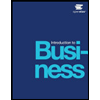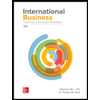suraj cw 2 V1
docx
keyboard_arrow_up
School
NMIMS Global Access School of Continuing Education *
*We aren’t endorsed by this school
Course
276
Subject
Business
Date
Nov 24, 2024
Type
docx
Pages
11
Uploaded by MateBookRhinoceros10
INTERNATIONAL BUSINESS
STRATEGY
Contents
Introduction
...........................................................................................................................................
1
Internal Environment: SWOT Analysis
...................................................................................................
1
External Environment: PESTLE Analysis
.................................................................................................
3
Strategic Goals
.......................................................................................................................................
6
Porter’s Generic Strategy
...................................................................................................................
6
Strategic Recommendations
..................................................................................................................
7
Marketing
..........................................................................................................................................
7
E-Commerce
......................................................................................................................................
7
Sustainability
.....................................................................................................................................
8
Conclusion
.............................................................................................................................................
9
References
...........................................................................................................................................
10
Introduction
With a brand value of $14.7 billion and projected revenues of $21.9 billion in 2020, Zara has
established itself as among the most profitable retail fashion companies currently. The company has
expanded into the textile business with the merger of Zara Home, which offers clothes, footwear, and
products for men, women, and children (
Allam et al., 2020).
The company has grown to become the
most dominant international fashion label, with a presence in 96 countries and close to 3,000 retail
locations throughout the world. Inditex, which includes Zara and other brands including Bershka,
Pull&Bear, and Massimo Dutti, employs approximately 176,000 people and dominates the retail
industry. Founded on the principles of "give customers what they want, and bring it to them faster
than anybody else," Zara operates based on the principles of elegance, simplicity, efficiency, and
durability (Runa, 2022).
Internal Environment: SWOT Analysis
Strengths
-
Zara's many competitive advantages have made it not just the most successful and widely
recognised of Inditex's many brands, but also a major player in the global fashion retail
market.
-
Since the company's online and retail collections are updated twice weekly, new styles may
be introduced to the market in less than 15 days, and shipping to any country takes no more
than 48 hours thanks to its 10 distribution hubs. With 2,118 locations throughout 202
countries, they dominate the world's retail fashion industry (Inditex) (Segran, 2019).
-
More than 700 talented designers work with Inditex to translate shoppers' wishes into
products. Zara's designers release 50,000 new creations annually to keep up with the fast
fashion industry. Their three-week product development cycle is in stark contrast to the
months it takes for other firms to get their items to market. Customers are pleased with both
the variety of high-quality clothing options and the low prices (
Gheorghe and Matefi, 2021).
-
The company's mission is summed up as meeting the needs of the customers through the
great experience," putting the customer at the forefront of all they do (
Saraswat, 2018).
Weaknesses
The fast-fashion industry is dominated by Zara, yet the company has its shortcomings.
-
Clothing quality is low because it is difficult to strike a balance between replacing outdated
styles with new ones and a dedication to sustainability.
Your preview ends here
Eager to read complete document? Join bartleby learn and gain access to the full version
- Access to all documents
- Unlimited textbook solutions
- 24/7 expert homework help
-
Furthermore, Zara's wide variety of clothing and accessories for guys, females, and children
is diffuse and unfocused. Zara's wares are timeless basics that reflect current fashion trends.
As a result, customers may look elsewhere, perhaps toward labels that focus on specific
product categories, such as denim or clothing (Su, 2020).
-
When people all over the world were quarantined and forced into social isolation in 2019,
Zara's reliance on its brick-and-mortar stores became obvious.
-
Zara, unlike many of its competitors, spends relatively little money on advertising and instead
relies on social media and PR to build its brand. It has achieved widespread popularity by
successfully appealing to and satisfying the needs of its target market. Nonetheless, it lacks a
robust marketing plan and will face future hurdles as competition becomes more intense
(Giri et al., 2018).
Opportunities
-
The retail industry in the digital age is predicted to be drastically altered by the predicted
$36.8 billion in global AI revenues by 2025, up from 2016's $643.7 million. A new era of retail
may be upon us thanks to its investment in and use of artificial intelligence and related
technologies (Mehta, 2021). The use of these advances could lead to more comprehensive
data collection, which in turn could pave the way for more personalised client experiences or
even the creation of virtual ones.
-
Zara relies heavily on its retail locations, but the company may find success by expanding its
business online. As more people start using smartphones, tablets, and laptops for online
communication, digitalization is altering the way we conduct our daily lives. The number of
individuals using the internet to shop increased to 1.92 billion in 2019, with online retail
sales reaching $3.5 trillion around the world. However, buyers often complain that Zara's
website is too cluttered, poorly written, or otherwise unusable. More effort put into digital
marketing and improving the e-commerce sector's functionality could increase the brand's
consumer base and the number of items sold (
Schaich et al., 2021).
-
Zara can also develop its retail infrastructure in less developed nations. Though it is well-
known in other countries, its popularity in Malaysia, India, and Singapore is quite low. A huge
population and promising business climate make these countries an attractive market for
Zara as it seeks to expand its global presence.
Threats
-
When it comes to potential dangers, Zara has to worry most about the abundance and
quality of rivals in its field. Zara now has to compete with a plethora of new entrants, many
of which operate solely online and provide identical goods at lower prices than Zara does.
Businesses like Shien and Romwe, which offer tees for as little as $5, have cropped up to
meet the surging demand for reasonably priced, on-trend garments. Because of this, Zara's
business model is in jeopardy as it attempts to compete with cheaper imitations (Feiglová,
2019).
-
Due to its global presence and competitiveness in 202 markets, Zara is vulnerable to the
impact of trade restrictions and foreign business legislation. To operate legally, the
corporation must adhere to all applicable labour and business laws in each jurisdiction in
which it operates. Many European countries shut down their borders and businesses when
the virus first hit. Because of the lockdown procedures, manufacturing processes and supply
links were severely disrupted. As the pandemic continues to spread, Zara must take
precautions as she readjusts to the new reality and prepares her business for post-pandemic
operations (Runa, 2022).
External Environment: PESTLE Analysis
Political Factors
The retail sector is strongly influenced by political concerns. The ability of retail brands to conduct
business globally is highly sensitive to the political context. Widespread free trade policies and trade
pacts facilitate trade between companies and the movement of goods. Although overseeing
production and other abroad businesses can be difficult, supply chains and sales can be readily
disrupted by high taxation and trade obstacles. In light of this potential increase in taxes, the
government may encourage citizens to shop locally for supplies.
Economic Factors
Consumers' willingness to spending is influenced by numerous variables, including the state of the
economy, which can either stimulate or chill outlays of cash. Spending increases and consumers have
more faith in the value of their dollars when the economy is doing well. Customers are now in a
stronger opportunity to invest in their aesthetic by buying clothes and accessories. On the flip side,
pessimism is more common during economic downturns and periods of high unemployment. When
money is tight, the basics, like food and shelter, have to be paid for first. There could be a drop in
retail sales and earnings. There is more opportunity for profit from retail prices as the economy
improves (Gheorghe and Matefi, 2021).
Social Factors
The retail industry feels the long-term effects of rapidly changing demographic and socioeconomic
groups. Since the advent of social media, particularly among the younger generations (millennials
and Gen Z), consumer tastes have been known to shift swiftly. It is projected that by 2023, 3.43
billion individuals will use social media, and that these users would consume an average of 144
minutes per day engaging with content across all platforms (López et al., 2022). Businesses are
adjusting their customer service strategies to take into account the growing importance of social
media. Paid advertisements, celebrity endorsements, and public relations efforts all help the major
players in this industry gain more attention and customers. Instagram, Tik Tok, Facebook, Pinterest,
and Twitter are just a few of the most popular social media platforms where people can readily
obtain fashion ideas and current trends. Since fashion fads spread like wildfire and fade just as
rapidly, consumers are perpetually on the prowl for fresh fast-fashion offerings. Consequently,
making good use of social media and keeping up with the latest trends is crucial to your success
(Schaich et al., 2021).
As there are so many businesses to pick from, and consumers have so many options, marketers are
focusing more on the quality of the customer experience they provide. Customers have cheap
switching costs, so if they have a bad experience with a brand, they are likely to stop patronising it.
Alternatively, if customers are happy with their interactions with the firm, they are more likely to be
repeat buyers and spread the word about the company, which in turn can boost sales. The revenue
generated from a totally content client is 2.6% higher than that of a customer who is only "slightly
satisfied," and the revenue generated from a customer who is "somewhat dissatisfied" is 14% higher.
Keeping an established clientele is much less work and more cost-effective than bringing in new ones
(
Feiglová, 2019).
Technological Factors
Sales, distribution networks, and customer care have all benefited greatly from technological
advancements. The proliferation of fashion retail businesses is a direct result of the lowering of
entrance barriers made possible by developments in digital technology. Online retailing allows
companies and individuals to bypass the need to set up physical locations for product distribution. By
2021, online shopping is expected to be responsible for 18.1% of overall retail sales worldwide,
which poses a serious threat to traditional stores (Mehta, 2021).
Your preview ends here
Eager to read complete document? Join bartleby learn and gain access to the full version
- Access to all documents
- Unlimited textbook solutions
- 24/7 expert homework help
Big Data tools, such as blockchain technology, make it less cumbersome and more cost-effective for
businesses to store and maintain data like product histories, transaction records, and when and
where goods were made. Since today's tech-savvy consumers expect greater candour from retailers,
More so, upcoming technological advancements are anticipated to have revolutionary effects on the
retail sector and the consumer experience (
López et al., 2022).
Legal Factors
As more companies produce their goods overseas, issues like worker rights and child labour
restrictions have come into the spotlight. Full-time and part-time employees in the business sector as
well as federal, state, and municipal governments are covered by the Fair Labor Rules Act, which
mandates basic wage, overtime qualification, documentation, and child labour standards. Supporters
of laborers' rights, such as the protection of basic human rights and the restriction of forced labour,
should be given prominence on a global as well as a local scale. If a company is exposed using
sweatshop labour, it can do serious damage to its reputation because consumers will see the
company as unethical and may choose to boycott the product (
Feiglová, 2019).
Environmental Factors
Living a "Green" or eco-friendly lifestyle has gained popularity in the modern era. Consumers are
becoming increasingly conscientious and knowledgeable, with many fretting over the potential
environmental consequences of their choices. Customers are paying closer attention to retailers that
stock eco-friendly and ethically made products. According to research by McKinsey & Company, the
majority of consumers (67%) consider a company's commitment to environmental responsibility
(63%) to be a major factor when making purchasing decisions (Gheorghe and Matefi, 2021). In order
to appeal to environmentally aware shoppers, more and more textile producers are adopting
sustainable practises like greener sourcing and longer-lasting packaging (Allam et al., 2020).
Strategic Goals
Porter’s Generic Strategy
Figure 1: Porter's Generic Strategy
Zara's overall business strategy is to be a cost leader. The brand has an advantage over its rivals since
it can compete with higher-priced labels yet having a more accessible price point. Nonetheless, these
are but a few examples of how Zara is different from the others. It is committed to what it calls the
"whole cycle of life," or the way in which a product maintains or increases its worth by careful and
ethical treatment throughout its entire life cycle (Mehta, 2021). Therefore, the ultimate aim is to
provide in-store and online customers with high-quality items that were produced in an ethical
manner at every stage. The following intermediate and short-term objectives will help bring about
this objective:
Short-term goal
Improving its advertising methods and
building a stronger online storefront are two
priorities
Medium-term goal
Focus on incorporating sustainable business
practises into its operations in the near future
Long-term goal
To provide in-store and online customers with
high-quality items that were produced in an
ethical manner at every stage
Strategic Recommendations
Marketing
If it wants to keep its dominant position in the expanding fashion retail industry, Zara will need to
take steps to strengthen itself against potential threats and capitalise on emerging opportunities. The
store mostly advertises on Instagram and Facebook, and also uses its brand on the shopping bags. It
employs anti-marketing strategies by enticing rather than pressuring customers to buy its wares, and
it devotes just about 0.3% of its sales on advertising (Allam et al., 2020). In order to compete with
the many new companies that are likely to appear in the near future to attempt to replicate Zara's
success, the company will need to develop an effective marketing plan. Rival H&M uses SMS
vouchers and mail sales campaigns, as well as collaborations with high-end designers and
celebrities to attract customers to its stores. Given Zara's large internet following, the company could
benefit from participating in influencer marketing (Runa, 2022).
E-Commerce
Zara also needs to expand its internet presence. In terms of the company's overall strengths, Zara's
online store is not a particularly shining example. The company should improve the site's usability.
The current design places too much emphasis on visual appeal, which makes it difficult for the user
to browse the site and identify the advertised goods due to the model's minimally expressive
expressions and the distracting nature of the design. Other people have mentioned that the online
shop's tabs are hard to navigate and that the site's layout doesn't translate well to mobile devices.
The website may benefit from a cleaner look and a more streamlined way of browsing products as a
whole without sacrificing any of the unique personality that made it successful. Zara's online
storefront needs more personalised service from either in-house or contracted user interface/user
experience designers or other experts in order to match shoppers' expectations (
Allam et al., 2020).
Sustainability
Two concepts that don't go together at all: fast fashion and sustainability. However, Zara faces
competition from a subset of the fast fashion industry due to its commitment to environmental
sustainability. The extent to which Zara will adhere to its promise to the environment through
responsible and ethical sourcing and manufacturing is a matter of some conjecture. Zara might
further demonstrate its commitment to sustainability by inviting customers to help shape the brand's
future eco-friendly offerings. Knowing you're supporting a sustainable company is nice, but getting
involved is where the real change happens. Zara might implement an upcycling programme similar to
H&M's clothes collection, in which customers receive a 15% discount on their next purchase in
exchange for donating their gently worn apparel. Customers could return their lightly used, but still
wearable, Zara apparel for recycling or distribution to developing nations (Runa, 2022).
Your preview ends here
Eager to read complete document? Join bartleby learn and gain access to the full version
- Access to all documents
- Unlimited textbook solutions
- 24/7 expert homework help
Technically Correct
Politically
Supportable
Organizationally
Implementable
Improving its
advertising methods
and building a
stronger online
storefront are two
priorities
This strategy will help
to address the issue of
competition because
effective marketing is
very important to go
ahead from
competitors like H&M
This strategy will help
to maintain good
customer relationship
Zara is a massive
company with an
annual revenue of
$21.9 billion in 2020.
Hence, it have the
capacity to invest in
promotional activities
Focus on
incorporating
sustainable business
practises into its
operations in the near
future
Sustainable business
practices have
become a necessity to
protect environment
Government itself is
promoting sustainable
practices in clothing
sector
There are many
sustainable
alternatives available
in fashion industry.
To provide in-store
and online customers
with high-quality
items that were
produced in an ethical
manner at every stage
This objective focuses
on well-being of
customers and
environment
Government support
ethical business
practices.
Zara have a strong
presence globally and
financially and its
brand image is also
strong. Hence, it can
provide high-quality
products in
sustainable manner
Conclusion
The Spanish clothing company Zara has expanded rapidly since its founding in 1975 to become the
largest fashion shop on the planet. Worldwide, the company's stores and e-commerce platform
dominate the fast fashion market because of the advantages it has from vertical integration and low
prices. However, the sector as a whole is expanding at a quick rate, so Zara will need to work hard to
keep up with the competition by strengthening its marketing, expanding its online presence, and
maintaining its dedication to environmental sustainability.
References
Allam, I., Scagnelli, S. and Corazza, L., 2020. Sustainability reporting, a new type of companies’
hypocrisy: Zara and Volkswagen cases. In
Responsible Business in a Changing World
(pp. 195-211).
Springer, Cham.
Feiglová, M., 2019. Attitudes of Generation Y to Fashion Comsumption: The Zara Case.
Gheorghe, C.A. and Matefi, R., 2021. Sustainability and Transparency—Necessary Conditions for the
Transition from Fast to Slow Fashion: Zara Join Life Collection’s Analysis.
Sustainability
,
13
(19),
p.11013.
Giri, C., Harale, N., Thomassey, S. and Zeng, X., 2018. Analysis of consumer emotions about fashion
brands: An exploratory study. In
Data Science and Knowledge Engineering for Sensing Decision
Support: Proceedings of the 13th International FLINS Conference (FLINS 2018)
(pp. 1567-1574).
López, T., Riedler, T., Köhnen, H. and Fütterer, M., 2022. Digital value chain restructuring and labour
process transformations in the fast
fashion sector: Evidence from the value chains of Zara &
‐
H&M.
Global Networks
,
22
(4), pp.684-700.
Mehta, M., 2021.
Study of Supply Chain Strategies implemented by various companies in Fast
Fashion Industry
(Doctoral dissertation, School of Petroleum Management).
Saraswat, S., 2018. Strategies v/s Consumer Perception of Brand Zara-India.
IITM Journal of
Management and IT
,
9
(2), pp.68-80.
Segran, E.L.I.Z.A.B.E.T.H., 2019. H&M, Zara, and other fashion brands are tricking shoppers with
vague sustainability claims.
Fast Company
,
8
.
Su, Y.Z., 2020. The Internationalization Strategies of Fast Fashion Clothing Retailer Brands: A Cases
Study of ZARA, H&M, UNIQLO, and Gap.
Schaich Graniel, D., Finnell, A., Hopkins, C., Salters, C., Baez, E., Hernandez, L., McIntyre, M. and Lee,
R., 2021. Zara: Facing Fast Fashion Challenges in China. An International Marketing Case Study.
Runa, C.R.N.W., 2022.
Business Model Canvas (BMC)-ZARA
(No. 9p8yw). Center for Open Science.
Related Documents
Recommended textbooks for you

BUSN 11 Introduction to Business Student Edition
Business
ISBN:9781337407137
Author:Kelly
Publisher:Cengage Learning

Essentials of Business Communication (MindTap Cou...
Business
ISBN:9781337386494
Author:Mary Ellen Guffey, Dana Loewy
Publisher:Cengage Learning

Accounting Information Systems (14th Edition)
Business
ISBN:9780134474021
Author:Marshall B. Romney, Paul J. Steinbart
Publisher:PEARSON


International Business: Competing in the Global M...
Business
ISBN:9781259929441
Author:Charles W. L. Hill Dr, G. Tomas M. Hult
Publisher:McGraw-Hill Education

Recommended textbooks for you
 BUSN 11 Introduction to Business Student EditionBusinessISBN:9781337407137Author:KellyPublisher:Cengage Learning
BUSN 11 Introduction to Business Student EditionBusinessISBN:9781337407137Author:KellyPublisher:Cengage Learning Essentials of Business Communication (MindTap Cou...BusinessISBN:9781337386494Author:Mary Ellen Guffey, Dana LoewyPublisher:Cengage Learning
Essentials of Business Communication (MindTap Cou...BusinessISBN:9781337386494Author:Mary Ellen Guffey, Dana LoewyPublisher:Cengage Learning Accounting Information Systems (14th Edition)BusinessISBN:9780134474021Author:Marshall B. Romney, Paul J. SteinbartPublisher:PEARSON
Accounting Information Systems (14th Edition)BusinessISBN:9780134474021Author:Marshall B. Romney, Paul J. SteinbartPublisher:PEARSON
 International Business: Competing in the Global M...BusinessISBN:9781259929441Author:Charles W. L. Hill Dr, G. Tomas M. HultPublisher:McGraw-Hill Education
International Business: Competing in the Global M...BusinessISBN:9781259929441Author:Charles W. L. Hill Dr, G. Tomas M. HultPublisher:McGraw-Hill Education

BUSN 11 Introduction to Business Student Edition
Business
ISBN:9781337407137
Author:Kelly
Publisher:Cengage Learning

Essentials of Business Communication (MindTap Cou...
Business
ISBN:9781337386494
Author:Mary Ellen Guffey, Dana Loewy
Publisher:Cengage Learning

Accounting Information Systems (14th Edition)
Business
ISBN:9780134474021
Author:Marshall B. Romney, Paul J. Steinbart
Publisher:PEARSON


International Business: Competing in the Global M...
Business
ISBN:9781259929441
Author:Charles W. L. Hill Dr, G. Tomas M. Hult
Publisher:McGraw-Hill Education
